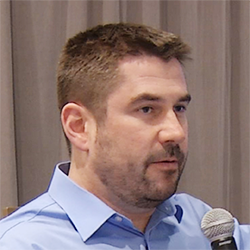Home » Coexisting Conditions » EDS, POTS, & MCAS with Dr. Juan Camilo Guzman, MD, MSc, FRCPC
EDS, POTS & MCAS with Dr. Juan Camilo Guzman, MD MSc, FRCPC
Video Transcript
Mr. Al Ruechel: Hello everyone, I’m Al Ruechel. Thank you for joining us. We continue to have discussions about POTS and dysautonomia and other ANS systems. Joining me right now is Dr. Juan Guzman. Dr. Guzman thank you for stopping by.
Dr. Juan Guzman: Thank you for having me today.
Mr. Ruechel: Okay, give me a little bit about your background and how you’re involved with dysautonomias in general.
Dr. Guzman: So, I train in the internal medicine. I do fellowship in autonomic disorders back in 2000s in Canada. I am originally from Colombia but I went to Canada when I was in my 20s to pursue my medical education. And I did my speciality and then decided to settle and start my practice and I have been in practice for 10 years with special interest in autonomic disorder, so I see patient with POTS, syncope, and orthostatic intolerance syndromes in general.
Mr. Ruechel: And you’ve been seeing more and more patients because everybody has been seeing more as either more are being diagnosed or more have these conditions. I mean it’s kind of hard to tell which way it goes.
Dr. Guzman: In the last few years, I think people are more aware about the conditions and two the physicians are more aware in the community. So, we are getting more and more and more referrals to our clinics in general, and certainly we are able to provide better care to these patients because unfortunately these patients are always lost in the space. And a lot of time to the point that they have the diagnosis and especially the treatment that they need for rehabilitation because these conditions in general, dysautonomias, are impaired the quality of life severely.
Mr. Ruechel: Yeah. So, we are going to talk about coexisting conditions and we’ve talked about these before. So, we’re going to talk about EDS, POTS and MCAS and let’s just hope for definition purposes, let’s go for each one of those, EDS stand for?
Dr. Guzman: EDS stands for Ehlers–Danlos syndrome. So, it is a group of connective tissue disorders. Connective tissues are the connectors between different organs, blood vessels, muscles and so on, so this is a congenital disorder that affects those connectors and produce a different type of conditions like joint hypermobility, stretchy skin, easy bruising, stretch marks, so all these organs intertwine, they are affected by this condition. There are different types, there are at least 13 types of connective tissue disorders, EDS. But the one particular that associated with dysautonomias is called hypermobility type and this condition has some sort of general size, hypermobility so double joints if you have heard in the past and number 2, some general symptoms, systemic symptoms. It could be cardiovascular symptoms like dysautonomias, POTS for instance, it could be heart damage like mitral valve prolapse and other conditions plus also no association with other diseases.
Mr. Ruechel: And then we have POTS, which we’ve talked about a lot, and most people try to understand what that is and then MCAS.
Dr. Guzman: So, MCAS is another subtype of condition associated with the release of histamine mediators. So, histamine, it’s an abnormal release of histamine basically, and histamine is a hormone that help us to deal with infections. So basically, destroys or bugs and also enhance the potential of the antibodies and helping the body to fight infections in general plus also it’s involving allergies as well, itchiness is called by histamine, it is produced by histamine. So, we have seen this association between POTS and mast cell activation disorders.
Mr. Ruechel: That’s what we’re going to talk about now and now that we have kind of defined the three. How do they interact with each other? How does one affect the others?
Dr. Guzman: I think we need to start from EDS and POTS, right. So, patients as I mentioned before, they are more prone to get orthostatic intolerance and, in these patients, also they are more prone to have POTS. From the other side we saw patients with mast cell activation disorder that they were having symptoms of POTS having dizziness, lightheadedness, a lot of GI symptoms which is basically what happened in patients with mast cell activation syndromes and then we made a connection, it came from patients in my clinic. So, a patient tell me okay I have mast cell activation syndrome, I have this weird itchiness, so we look in the literature and we found some reports making these connections and we eventually, I work in Toronto with St. Michael’s Hospital, Dr. Peter Vadas who I connect with, did work with and we actually look at a suite of cases and we found that connection between these three conditions. Patients with EDS and POTS they were seen in our EDS Clinic in Toronto, in my clinic in Hamilton and in his clinic.
Mr. Ruechel: So, in most of these cases do you see this most often and then I say which comes first or do we know?
Dr. Guzman: Again, there is no cause-effect at the moment because we don’t have enough data. There’s something that has come out in the last probably I would 10 years in the literature and there is small research group that I’m trying to find out what is the special link. I mean we suspect that the histamine cause dilation of the blood vessels, patients with EDS, they are more prone to have dilated vessels, right, that certainly increases the chances of developing dysautonomias or POTS because the heart what it’s going to do is try to compensate, try to fight this venous pooling, so all the blood volume will be in your lower limbs, so you’re not going to be able to maintain the blood flow in your brain and that’s how you are going to have these symptoms of dizziness and your heart basically what it does is increase your heartbeat and that’s how you know the symptoms of tachycardia, chronic fatigue, brain frog, and all the symptoms that POTS has.
Mr. Ruechel: How do you come up with a regime and I’m thinking other because if you start using drugs then those have other interactions with each other and make it even more complicated or because each one of those symptoms must respond differently.
Dr. Guzman: Absolutely, there is one thing in patients with EDS, they have a lot of chronic pain and certain medications for chronic pain like an opioid you have also effects on blood pressure. So, you are making things worse because patients with EDS, they are more prone to have POTS or dysautonomias and you are giving medication that are actually may increase the chances of having these events. Now if we add the mast cell activation syndrome then we have more and more and more serious symptoms. However, patients with mast cell activation syndromes, they actually respond pretty well to what we call histamine blockers and those are the common over-the-counter, ranitidine, cetirizine, the medication that in general population use for allergies. So actually, the treatment for mast cell activation syndrome is cheap and accessible to patients, but to make the connection what I think is a challenge and what certainly some physicians struggle with.
Mr. Ruechel: So, are these conditions that will last rest of their life?
Dr. Guzman: I mean first of all EDS is a congenital disorder, so it comes in the package what I tell my patients about. However, certainly POTS and mast cell activation syndrome are diseases or conditions that you treat symptomatically. We still don’t know the cause; we still don’t know the connection and there is controversy around these conditions but these certainly respond to empirical therapy what we call empirical therapy very well.
Mr. Ruechel: Is there any one demographic group in particular that is more susceptible to what would we call to this cluster?
Dr. Guzman: I think what we are doing is when in the clinic in Toronto, we are trying to develop a register of these patients, right, so you need to know the history of the disease first, the natural history of the disease. So, the first step in doing research is know what we have or what patients are they wondered having these conditions, what the natural history, and what the journey of the patient has, so that is what we are doing now. We do not have data but anecdotally I can tell you that these happen in young female adults, particularly Caucasian patients, so very, very, very rare in males and elderly population.
Mr. Ruechel: So, we’re trying to teach doctors obviously we hit the data right now so if you have a message for a doctor that is watching this right now, what would have been in regards to what we are talking about?
Dr. Guzman: I think of things out of box. There is different point of entry. Right? So a patient can come from EDS Clinic, patient can come from a cardiology neurology diagnosed in POTS or can come from allergy immunology, so what we want is to make sure is that they are aware that this connection exists and there are easy way to diagnose, number 1; and number 2, that there are treatment that are available for those patients.
Mr. Ruechel: Right, and for the patients that are watching this, they may have been struggling for months or in some cases years trying to figure out what’s going on with their bodies.
Dr. Guzman: Absolutely, I mean I think at the end of the day for those patients we want to make sure it improves their quality of life and if you identify the disease and if you target a therapy, you certainly improve the outcomes and the patient can rehabilitate and can come back to their baselines.
Mr. Ruechel: Great, doctor thank you so much. I appreciate your time.
Dr. Guzman: Thank you so much for having me.
Mr. Ruechel: Keep up the good work.
Dr. Guzman: Thank you.
Visit our Education Center for Autonomic Disorders for additional video resources for patients and providers.

Wolfgang Singer, MD
Associate Professor of Neurology
Mayo Clinic Rochester, MN































